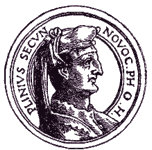
[sitemap de/eng]
Plinius Secundus, Cajus, geb. 23 Como oder Verona, gest. 25.8.79 am Vesuv, römischer Naturforscher und Schriftsteller, Hauptwerk die 'Naturgeschichte' (Naturalis Historiae).
X. Vetustissima inventu paeoina est. nomenque auctoris retinet. quam quidum pentorobon appellant. alii glycysidem. nam haec quoque difficultas est quod eadem aliter alibi nuncupatur. nascitur opacis montibus caule inter lolia digitorum quattuor ferente in cacumine veluti Graecas nuces quattuor aut quinque. inest his semem eopiosum. rbrum nigrumque. haec medetur et Faunorum in quiete ludibriis. praecipiunt eruere noctu, quoniam si picus Martius videat tuendo in oculos impetum faciat.
|
29 |
Vetustissima inventu Paeonia est nomenque auctoris retinet, quam quidam pentorobon appellant, alii glycysiden. nam haec quoque difficultas est, quod eadem aliter alibi nuncupatur. nascitur opacis montibus, caule inter folia digitorum IIII, ferente in cacumine veluti Graecas nuces IIII aut V. inest his semen copiosum, rubrum nigrumque. haec medetur et Faunorum in quiete ludibriis. praecipiunt eruere noctu, quoniam, si picus Martius videat, tuendo in oculos impetum faciat. |
X. The first plant to be discoveres was the peony, which still retains the name of the discoverer; it is called by some pentorobon. by others glycyside. for an added difficulty in botany is the variety of names given to the same plant in different districts. It grows on shaded mountains, having a stem among the leaves about four fongers high, which bears on its top four or five growths like almonds, in them being a large amount of seed. red and black. This plant also prevents the mocking delusions that the Fauns bring on us in our sleep. They recommend us to uproot it at night-time, because the woodpecker of Mars, should be see the act. will attack the eves in its defence.
[Pliny, Natural History (Loeb Classical Library) 7:156-157 (1955) edited and translated by H.S. Jones).
The woodpecker superstition mentioned here by Pliny and earlier by Theophrastos (page l6) is in some way connected with the ancient pre-christian veneration of the woodpecker as an oracular bird of the God Mars and guardian of sacred groves, presumably the great red-capped black woodpecker (Dyocopus martius syn. Picus martius L.); see E.A. Armstrong. The Folklore of Birds, an Enquiry into the Origin of some Magical Religious Traditions 93-112 (1958).
PLINY'S ACCOUNT OF PAEONIA
The Roman encyclopedist Pliny the Elder (1st cent. A.D.) was a contemporary of Dioscorides but, despite 106 almost identical passages in their works listed by Max Wellmann (1889), there is no reason to suppose that either author knew of the other: both drew upon the same earlier Greek sources, notably a now lost work of the 1st century B.C. by Sextius Niger, according to Wellmann. Pliny too included paeonia and, like Dioscorides, gave pentorobon and glycyside as alternative names. His account, as translated by H.S. Jones (1955), reads: "The first plant to be discovered was the peony which still retains the name of the discoverer [Paeon]; it is called by some pentorobon, by others glycyside, for an added difficulty in botany is the variety of names given to the same plant in different districts. It grows on shaded mountains, having a stem among the leaves, which bears on its top four or five growths like almonds, in them being a large amount of seed, red and black. This plant also prevents the mocking delusions that the Fauns bring on us in our sleep. They recommend us to uproot it at night-time, because the woodpecker of Mars, should he see the act, will attack the eyes in its defence" (Nat. Hist., XXV, cap. 10; Loeb Class, Lib. 7: 157; 1955).
Stearn & Davis 1984
Pliny in Naturalis Historia also gives the name of Glycyside as the synonym of the paeony, saying there are two species, describing the roots of each kind in the same way as Dioscorides. He, in prophetic utterance, says, " there is a further difficulty in that the flower has different names in different places." He also repeats the same story of the woodpecker as Theophrastus.
Stern 1946
http://www.cso.co.at/bg19/latein/addon/plinius1.htm
http://www.ku-eichstaett.de/SLF/Klassphil/plinius/pliny.htm
http://www.toppoint.de/~cethegus/personen/p/pliniusda.html
http://www.rrz.uni-hamburg.de/biologie/b_online/d01/01b.htm
http://www.ukans.edu/history/index/europe/ancient_rome/E/Roman/Texts/Pliny_the_Elder/home.html
http://www.deutsches-museum.de/bib/entdeckt/alt_buch/buch0399.htm
http://www.deutsches-museum.de/bib/entdeckt/alt_buch/text0399.htm
http://www.mordor.ch/varius/am/hist/books/plinius1.html